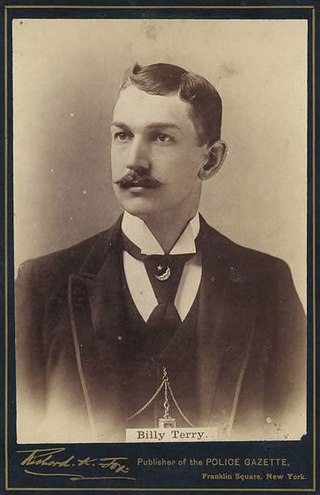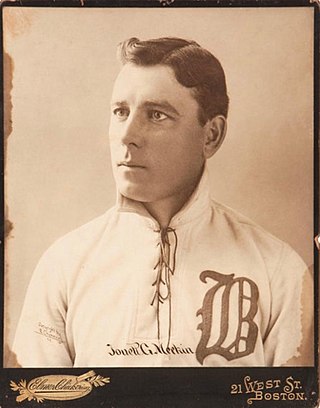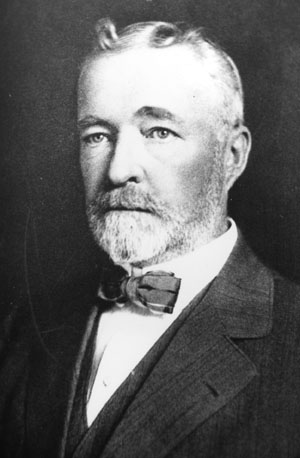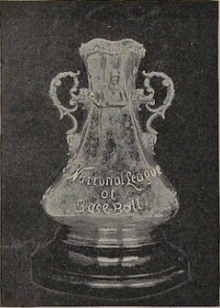
The Cleveland Spiders were an American professional baseball team based in Cleveland, Ohio. The team competed at the major league level from 1887 to 1899, first for two seasons as a member of the now-defunct American Association (AA), followed by eleven seasons in the National League (NL). Early names for the team included the Forest Citys and Blues. The name Spiders itself emerged early in the team's inaugural NL season of 1889, owing to new black-and-gray uniforms and the skinny, long-limbed look of many players. National League Park served as the team's home for its first four seasons until the opening of League Park in 1891.

Hugh Ambrose Jennings was an American professional baseball player, coach and manager from 1891 to 1925. Jennings was a leader, both as a batter and as a shortstop, with the Baltimore Orioles teams that won National League championships in 1894, 1895, and 1896. During those three seasons, Jennings had 355 runs batted in and hit .335, .386, and .401.
The American Association of Base Ball Clubs (AA) was a professional baseball league that existed for 10 seasons from 1882 to 1891. Together with the National League (NL), founded in 1876, the AA participated in an early version of the World Series seven times versus the champion of the NL in an interleague championship playoff tournament. At the end of its run, several AA franchises joined the NL. After 1891, the NL existed alone, with each season's champions being awarded the Temple Cup (1894–1897).

The Baltimore Orioles were a 19th-century professional baseball team that competed from 1882 to 1899, first in the American Association and later in the National League. This early Orioles franchise, which featured six players and a manager who were later inducted to the National Baseball Hall of Fame, finished in first place for three consecutive seasons (1894–1896) and won the Temple Cup national championship series in 1896 and 1897.

Edward Hugh Hanlon, also known as "Foxy Ned", and sometimes referred to as "the Father of Modern Baseball", was an American professional baseball player and manager whose career spanned from 1876 to 1914. He was posthumously inducted into the Baseball Hall of Fame in 1996 by the Veterans Committee.

Joseph James Kelley was an American left fielder in Major League Baseball (MLB) who starred in the outfield of the Baltimore Orioles teams of the 1890s. Making up the nucleus of the Orioles along with John McGraw, Willie Keeler, and Hughie Jennings, Kelley received the nickname "Kingpin of the Orioles".

Frank Gibson Selee was an American Major League Baseball manager in the National League (NL). In his 16-year Major League career, he managed the Boston Beaneaters (1890–1901) and Chicago Orphans / Cubs (1902–1905), winning 1,284 games. Selee managed the Beaneaters during their 1890s run of five NL championships. His 1892 and 1898 teams each won 100 games, becoming the first teams to ever achieve the mark in baseball history ; their 102 wins in each season would not be surpassed by a National League team until 1902. After joining the Orphans, he helped build the team that would become the Cubs dynasty of the 1900s. He was elected to the National Baseball Hall of Fame in 1999.

John Elmer Stivetts was an American professional baseball pitcher who played 11 seasons in Major League Baseball (MLB) spanning from 1889 to 1899. He played in the American Association (AA) with the St. Louis Browns, and in the National League (NL) with the Boston Beaneaters and Cleveland Spiders. "Happy Jack" was born to German immigrants and raised in Ashland, Pennsylvania. He initially followed his father into the coal mining industry before playing professional baseball. After playing 2+1⁄2 seasons in minor league baseball, he was signed by the Browns. Over the next few seasons, he was regarded as one of the best pitchers in baseball.

The International League (IL) is a Minor League Baseball league that operates in the United States. Along with the Pacific Coast League, it is one of two leagues playing at the Triple-A level, which is one grade below Major League Baseball (MLB).

William H. "Adonis" Terry was an American Major League Baseball player whose career spanned from his debut with the Brooklyn Atlantics in 1884, to the Chicago Colts in 1897. In his 14 seasons, he compiled a 197-196 win–loss record, winning 20 or more games in a season four different times.

Jacob Charles Stenzel was an American professional baseball player. He played as a center fielder in Major League Baseball from 1890 to 1899 for the Chicago Colts, Pittsburgh Pirates, Baltimore Orioles, St. Louis Browns / Perfectos, and Cincinnati Reds. Stenzel was 5 feet 10 inches (1.78 m) tall and weighed 168 pounds (76 kg).

George Jouett Meekin was a Major League Baseball pitcher from 1891 to 1900. He played for the Louisville Colonels, Washington Senators, New York Giants, Boston Beaneaters, and Pittsburgh Pirates. In 1894, he won 33 games for the Giants and helped lead the team to a championship.

John Joseph McGraw was an American Major League Baseball (MLB) player and manager who was for almost thirty years manager of the New York Giants. He was also the third baseman of the pennant-winning 1890s Baltimore Orioles teams, noted for their innovative, aggressive play.

William Chase Temple was a coal, citrus, and lumber baron during the late 19th and early 20th centuries. He was also a part owner of the Pittsburgh Pirates in Pittsburgh, Pennsylvania from baseball's National League of Professional Baseball Clubs, established 1876. He also established the Temple Cup, a silver trophy awarded to the winner of a best-of-seven, post-season Major League Baseball championship series that was conducted for four seasons in the National League, from 1894 to 1897. He became the first sole owner of a professional American football team, in 1898.
The Dauvray Cup was a championship trophy awarded in professional baseball from 1887 to 1893. Named after stage actress Helen Dauvray, who presented the cup, it was initially awarded to the winner of the World Series between the National League and American Association. It was the first World Series trophy. The last National League-American Association series was in 1890, with the latter collapsing after the end of the following season. The cup was then awarded to the winner of the National League pennant. Like the Stanley Cup of ice hockey, the same trophy was used each season rather than a new one being made. The Dauvray Cup has since been lost.
The 1969 Major League Baseball postseason was the playoff tournament of Major League Baseball for the 1969 season. It was the first edition of the new playoff system introduced by MLB, coinciding with the beginning of the "Divisional Era." Each league expanded from 10 teams to 12 teams and was divided into two 6-team divisions. The 162-game schedule stayed in place, but now each team played the other 5 teams in its own division 18 times each and the 6 teams in its league's other division 12 times each. The winners of each division advanced to the postseason and faced each other in a League Championship Series to determine the pennant winners that would face each other in the World Series.
The 1970 Major League Baseball postseason was the playoff tournament of Major League Baseball for the 1970 season. The winners of each division advance to the postseason and face each other in a League Championship Series to determine the pennant winners that face each other in the World Series.
The 1979 Major League Baseball postseason was the playoff tournament of Major League Baseball for the 1979 season. The winners of each division advance to the postseason and face each other in a League Championship Series to determine the pennant winners that face each other in the World Series.



















